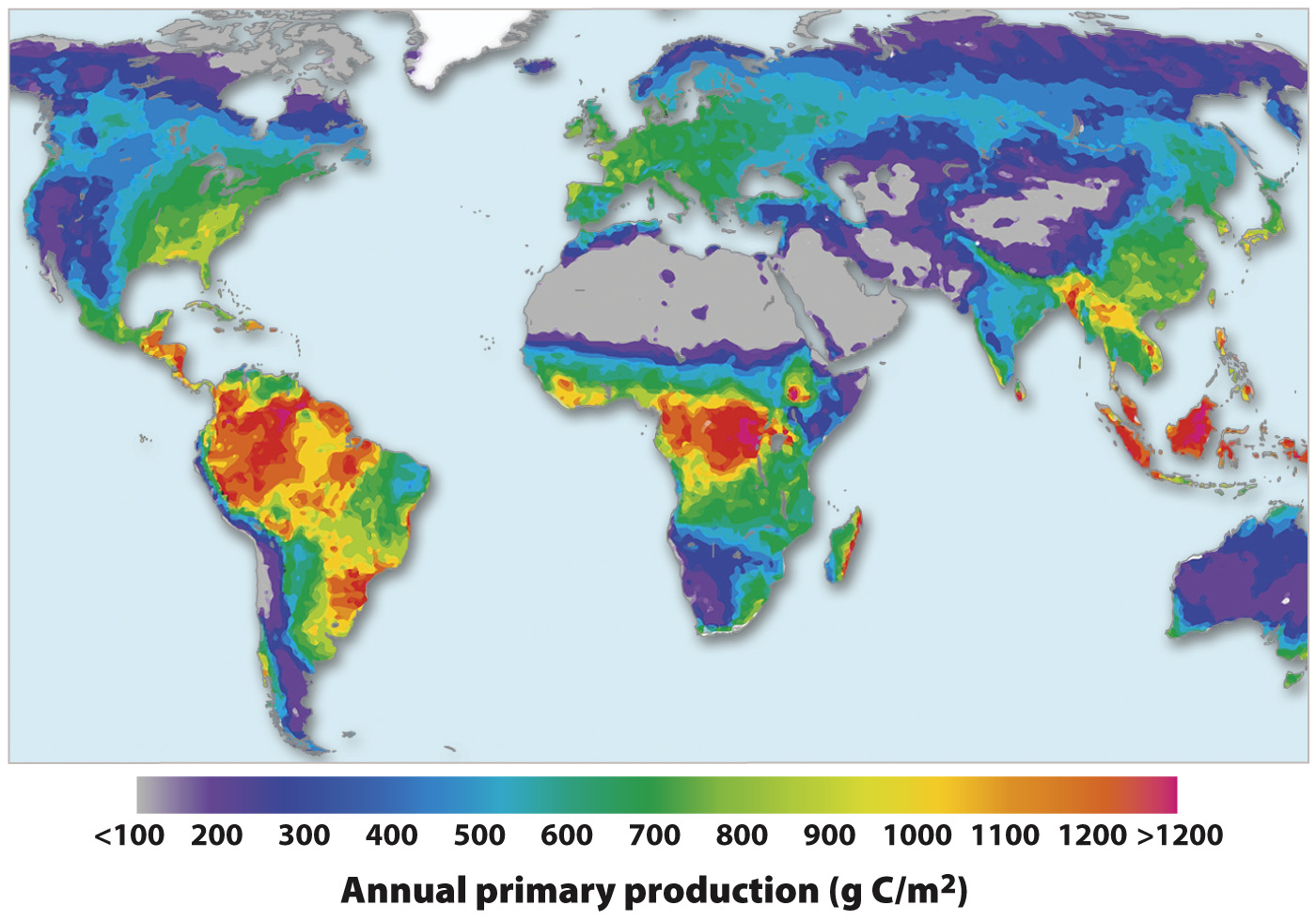Global patterns of primary production reflect variations in climate and nutrient availability.
Our review of biogeochemical cycles underscores the importance of primary production to ecosystems and biomes, but what controls rates of primary production? In Chapter 47, we saw that climate and nutrient limitation play important roles in determining the primary productivity of individual ecosystems. It stands to reason, then, that global patterns of primary production reflect planetary-
Fig. 48.18 shows the global distribution of primary production on land. The similarity of this figure to maps of global evapotranspiration and precipitation (see Fig. 48.9) shows the strong control of climate on patterns of primary production. Warm and wet climates near the equator support highly productive forests, whereas dry habitats and cold environments with limited growing seasons have lower levels of primary productivity.

In contrast, examine Fig. 48.19, which shows how rates of photosynthesis vary in the marine realm. In the oceans, the relationship to global climatic zones is not so clear, which is unsurprising because, in aquatic ecosystems, water is not a limiting factor for photosynthesis. The principal pattern shown in Fig. 48.19 is one of high photosynthetic rates along the margins of continents and especially low rates in the central gyres of circulating oceans. As noted earlier in this chapter, rates of primary production are high near continents because runoff of nitrogen and phosphorus from the continents supplies abundant nutrients to the sea. Upwelling zones, where nutrient-

The relative amounts of carbon, nitrogen, and phosphorus in cells vary among organisms, but within relatively narrow limits. On average, cells contain 1 atom of phosphorus and 16 atoms of nitrogen for every 100 atoms of carbon, a correspondence called the Redfield ratio after the American biologist Alfred Redfield, who pioneered research on the elemental composition of marine organisms. (Vertebrate animals have a higher phosphorus requirement—
HOW DO WE KNOW?
FIG. 48.20
Does iron limit primary production in some parts of the oceans?
BACKGROUND Nitrogen and phosphorus are nutrients that are thought to limit primary production in the oceans, and, consistent with this hypothesis, the concentrations of nitrate and phosphate in surface oceans are generally very low. Regionally, however, nitrogen and phosphorus concentrations are high, indicating that primary producers are not making use of all available nutrients.
HYPOTHESIS In some parts of the oceans, iron—
EXPERIMENT Biologists John Martin and Steve Fitzwater sailed to subarctic waters of the northeastern Pacific Ocean, where high nitrogen and phosphorus concentrations suggested limitation by another nutrient. They collected samples of seawater, along with its phytoplankton, and added small amounts of iron to different samples: 1, 5, or 10 nanomoles per kilogram of sample (in the control sample, no iron was added). As photosynthesis proceeded over the course of a week, the researchers made daily measurements of chlorophyll concentration (an indicator of photosynthetic rate), as well as of the concentrations of nitrate and phosphate in the sample treatments.

RESULTS As the figure shows, over the course of the experiments, samples to which iron was added showed increased chlorophyll concentration and decreased levels of nitrogen and phosphorus, with higher additions of iron generally showing more pronounced effects. Controls with no added iron showed little change over the course of the experiment.
CONCLUSION In samples from the northeastern Pacific Ocean, addition of iron increased rates of photosynthesis, with more uptake of nitrogen and phosphorus. This supports the hypothesis that, in these waters, iron and not nitrogen or phosphorus limits primary production.
FOLLOW-
SOURCE Martin, J. H., and S. E. Fitzwater. 1988. “Iron-
1064
1065
Global patterns of primary production help to determine the properties of biomes, and, as we will see in the next section, primary production also helps determine global patterns of biological diversity.
Quick Check 4 Why do patterns of global primary production on land show strong latitudinal variation, whereas primary production in the oceans varies largely with distance from shore?
Quick Check 4 Answer
Primary production on land is governed largely by temperature and rainfall, which vary by latitude. In contrast, primary production in the sea is strongly limited by nutrient availability; continental margins receive nutrients released by chemical weathering on the continents and transported to the ocean by rivers. They are also sites of upwelling, where nutrient-